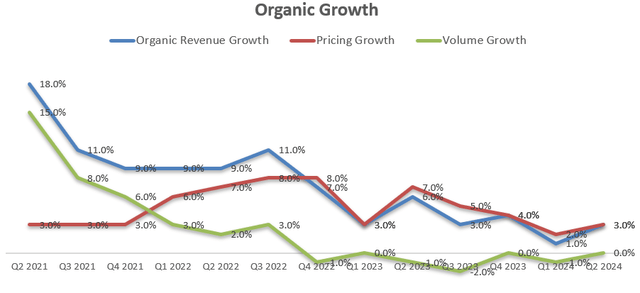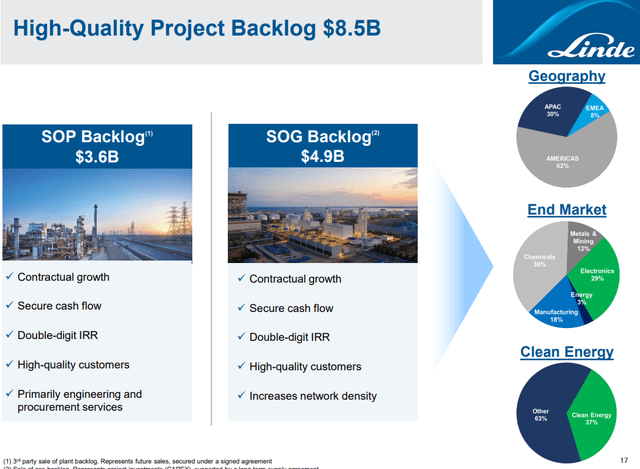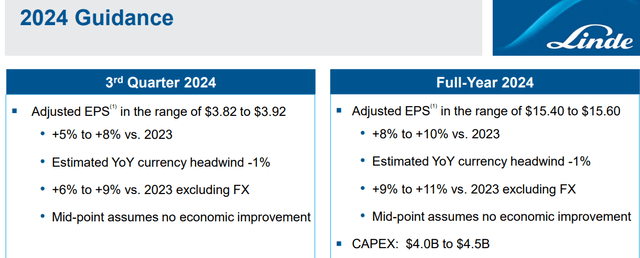I presented my ‘Buy’ thesis for Linde (NASDAQ:LIN) in March 2024, highlighting their double-digit EPS growth and effective cost management. Linde released its Q2 result on August 2nd, reporting 3% growth in underlying revenue and 6% growth in adjusted operating profits, guiding 9%-11% EPS growth for FY24. The guidance reaffirmed my analysis of the potential for double-digit earnings growth. Linde has demonstrated strong pricing and productivity growth despite flattish volume growth. I am encouraged by Linde’s project wins for large semiconductor manufacturing facilities. I reiterate a ‘Buy’ rating for Linde with a one-year target price of $520 per share.
Strong Pricing and Productivity Despite Weak Volume Growth
As depicted in the chart below, Linde delivered 3% organic revenue growth, comprising 3% pricing growth and flattish volume growth during the quarter. My biggest takeaway from the quarter is their strong growth in pricing and productivity, which contributed to strong earnings growth.

Linde Quarterly Earnings
Linde is guiding for flattish volume growth for the full year due to the weak overall industrial market in the U.S.; however, double-digit EPS growth is still anticipated for FY24. Key growth drivers include:
- As mentioned in the previous article, Linde maintains a consistent capital allocation policy, returning capital to shareholders via dividends and shares buyback. Year-to-date, Linde has repurchased $2.48 billion of own stocks and paid out $1.33 billion in dividends. I estimate that the shares repurchase could grow their EPS by 2% in the near future.
- Pricing and productivity are crucial for their gross margin expansion. During the earnings call, the management anticipated 4%-6% of EPS growth will come from their pricing and productivity initiatives. The company has done a great job optimizing their fixed costs over the past few years, which has contributed to improvements in productivity.
- Lastly, Linde is operating a cost pass-through model with their customers, which helps reduce the volatility associated with commodity inflation.
High-Quality Project Backlog
As depicted in the slide below, Linde has a high-quality project backlog totaling $8.5 billion. These backlogs pave the way for their near-term business growth, in my view. Specifically,37% of total projects are related to new energy initiatives, such as hydrogen and renewable energies.

Linde Investor Presentation
Linde has begun building on-site plants to supply ultra-high-purity nitrogen for TSMC’s (TSM) Phoenix manufacturing facility. During the earnings call, the management disclosed that phase one is already underway, with the project expected to contribute to Linde’s profits in the coming quarters. In addition, Linde has made progress on their build for Samsung project in Texas. With more global semiconductor companies constructing manufacture facilities in the U.S., I anticipate Line will become a major beneficiary.
On May 1st, 2024, Linde signed a long-term agreement with H2 Green Steel for the supply of industrial gases to the world’s first large-scale green steel production plant. As indicated in the release, these projects can help reduce carbon emissions by up to 95% compared to traditional steelmaking. I anticipate Linde will secure more contracts like this due to the global push towards clean energy and ESG initiatives.
Outlook and Valuation
Linde is guiding for 8%-10% EPS growth for FY24, as detailed in the slide below. The guidance is quite consistent with their historical performance.

Linde Investor Presentation
I am considering the following factors for their growth:
- The overall industrial production has been quite weak in 2024 due to the high-interest rate and weak consumption sentiments. As shown in the chart below, there has been almost no growth in industrial production during the first two quarters of 2024. As such, I don’t anticipate any volume growth for Linde in FY24. If the Fed enters an interest rate cut cycle in 2025, I forecast Linde’s volume growth will gradually recover to their historical average of 3%.

Federal Reserve Bank of St. Louis
- As discussed previously, pricing and productivity improvements are crucial to Linde’s overall growth. I anticipate they will sustain 3% pricing growth in the near future. As supply of industrial gas is mission-critical for manufacturing activities, customers tend to have less pricing negotiation power once the gas supply infrastructure is established.
- For the cost pass through growth, I forecast a 2% contribution in FY24, moderating to 1.5% as the inflation eases.
- Lastly, I anticipate Linde will allocate 0.3% of total revenues towards small acquisitions, contributing 10bps to overall growth.
As such, I calculate that Linde will deliver 5% growth in revenue for FY24, accelerating to 7.6% from FY25 onwards. I model an average of 50bps annual margin expansion for Linde assuming: 15bps from pricing; 15bps from productivity improvement; 10bps from SG&A operating leverage and 10bps from reducing depreciation costs.
With these assumptions, my DCF can be summarized as follows:

Linde DCF
The free cash flow from equity (FCFE) is calculated as follows:

Linde DCF
The cost of equity is calculated to be 8.6% as follows:

Linde Cost of Equity
Discounting all the FCFE, the one-year target price is estimated to be $520 per share, as per my calculations.
Key Risks
During the earnings call, the management expressed their concerns about their business growth in China. As China enters a deflation macro environment, Linde has been focusing on their pricing initiatives to improve profitability in China. The management lacks the confidence with the industrial market recovery in China, and in the near future, I anticipate Linde will continue to face growth challenges in China.
End Note
I favor Linde’s high-quality project backlogs, which has significant exposure to renewables and clean energy. The TSMC project is expected to generate profits for Linde soon. Despite flattish volume growth, I reiterate a ‘Buy’ rating for Linde with a one-year target price of $520 per share.
Read the full article here
